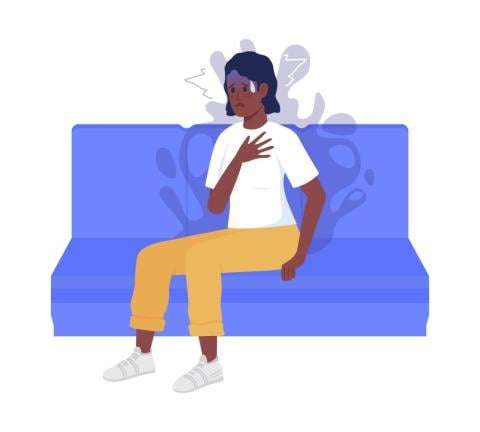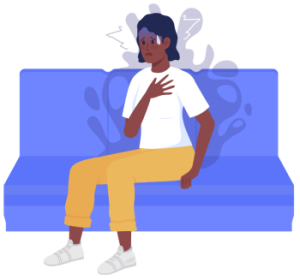Body Dysmorphic Disorder (BDD) consists of preoccupation with perceived flaws in one’s physical appearance. People with BDD think they look unattractive, ugly, or even hideous because of the perceived flaws, but in reality the flaws that they perceive are actually nonexistent or only slight. The appearance preoccupations cause significant distress or impairment in daily functioning (usually both).
BDD has similarities to obsessive-compulsive disorder (OCD); however, there are some important distinctions. Like OCD, people with BDD have obsessions that cause them anxiety and distress, and they try to alleviate their distress by engaging in compulsions (repetitive behaviors). Like OCD, the compulsions do not provide any pleasure. But people with BDD usually have less insight than those with OCD. They are also more likely to experience depression, thoughts that life isn’t worth living, and suicide attempts.
A common misconception about BDD is that it’s about vanity. Although some of the thoughts expressed by people with BDD might be misinterpreted this way, BDD is actually a brain-based disorder that involves abnormalities in visual perception – in how the brain actually sees things. It’s not just about beauty. BDD involves difficult-to-control obsessions and compulsive behaviors that are distressing and/or impairing, and it involves core beliefs of being worthless, unlikeable, or a failure due to the perceived physical flaws.
Common Obsessions in BDD
People with BDD focus on one or more body parts and the belief that they don’t look normal. Although BDD can affect any body part, some of the most common areas of concern are the skin, hair, nose, chin, lips, chest, and legs. The concerns can be related to shape, size, color, position, symmetry, etc.
Common Compulsions in BDD
BDD compulsions typically have a clear and direct connection to the obsessions. The distressing preoccupations trigger the compulsions. Among the most common compulsions are camouflaging (trying to hide or cover the perceived physical defects), comparing with others, checking mirrors and other reflecting surfaces, seeking cosmetic treatments and surgery, excessive grooming, reassurance-seeking, and touching the perceived flaw to check it. Avoidance is also extremely common among people with BDD, whether it be skipping social events where others could notice the perceived flaw or avoiding work or school.
When people with BDD engage in compulsions there is no pleasure involved. Individuals with BDD do not want to be doing compulsions, but their fears and anxiety about how they look drive them to perform the compulsions. On average, people with BDD spend an average of 3 to 8 hours a day obsessing about their perceived flaws and a similar amount of time performing BDD compulsive behaviors.
How is BDD Diagnosed?
Proper diagnosis of BDD by a specialized professional is crucial. It’s not uncommon for BDD to be misdiagnosed as an eating disorder, OCD, social anxiety, or even a psychotic disorder. When a patient isn’t correctly diagnosed, they will be treated for the wrong issue, and therefore the true problem will probably not improve.
In the United States, diagnosing BDD is based on diagnostic criteria set forth by the Diagnostic and Statistical Manual of Mental Disorders (DSM). Its current edition, the DSM 5-TR, sets forth three primary criteria for the diagnosis of BDD – preoccupation with at least one perceived physical flaw that is minimal or non-observable to others, compulsions due to the preoccupation with perceived physical defects, and the preoccupation causes clinically significant distress or significant impairment in functioning, such as work, school, or social life.
Who Gets BDD?
- 2.4% of adults in the United States struggle with BDD, almost equally between men and women (DSM-5-TR)
- 9-11% of dermatology patients, 13-15% of cosmetic surgery patients, 20% of rhinoplasty surgery patients, 11% of adult jaw correction surgery patients, and 5-13% of adult orthodontia/cosmetic dentistry patients have BDD (DSM-5-TR)
- Average age of the onset of BDD is 16-17 years old (DSM-5-TR)
- The most common age of onset is 12 or 13
- Two-thirds of people with BDD have onset of BDD before age 18 (DSM-5-TR)
How is BDD Treated?
One of the major complicating factors when treating BDD is lack of insight. Lack of insight means that most people with BDD think that they really do look ugly. They don’t realize that the physical flaws that they perceive are actually nonexistent or only slight in the eyes of other people. This is why so many people with BDD seek cosmetic treatment (which is almost never helpful) rather than mental health treatment, which is usually effective for BDD. Because BDD is often severe and can lead to suicidal thinking and behavior, it’s important that a mental health clinician who specializes in BDD be involved in treatment.
Enhancing motivation is key to starting therapy. Without engagement in the therapeutic process, no progress can be made. Motivational Interviewing can be extremely helpful in this process, as well as recognizing the ambivalence and resistance that’s often present in people with BDD. This work also can aid with keeping a person in treatment if they have setbacks in progress.
Cognitive behavioral therapy (CBT) is the first-line therapy for BDD, with specific protocols for the disorder. This includes psychoeducation, cognitive work on self-defeating thoughts, exposure and ritual prevention, and mirror retraining. Acceptance and Commitment Therapy (ACT), including values-based work, may be helpful when added to CBT, but research studies on the effectiveness of ACT for BDD are extremely limited, and more research studies are needed to see how effective it is for BDD.
Serotonin-reuptake inhibitors (SRIs, SSRIs) are the first-line medication treatment for BDD. SRIs include medications like fluoxetine (Prozac), sertraline (Zoloft), and escitalopram (Lexapro). These medications usually improve BDD obsessions and compulsive behaviors; reduce distress, anxiety, and depression; and improve functioning. Most people have no side effects, and these medications are not addicting or habit forming. SRIs and CBT can work very well together, and both treatments are recommended together for people who have severe BDD.
To learn more in-depth about Body Dysmorphic Disorder and treatments, check out ADAA's Patient Guide to Mood and Anxiety Disorders.
ADAA Resources
Personal Stories;
- Ode to Bipolar Disorder
- I Am Worth It!
- Finding my Own Silver Linings Playbook Through Mental Health Advocacy
Professional blogs and webinars:
- BDD, Surgeons, and Surgery: Considerations and Questions to Ask, Blog
- Residential Treatment for Youth with OCD: Answers to Your Top 3 Questions, Blog
- Body Dysmorphic Disorder (BDD) and Men: What to Know and How it Differs, Blog
- Beyond Physical Appearance: Understanding Body Dysmorphic Disorder, On Demand Webinar
- Body Dysmorphic Disorder (BDD): The Disease of Self-Perceived Ugliness and its Relationship to OCD, On Demand Webinar
- What Are the Pandemic Side Effects on Those with BDD and OCD?, Blog
- It's Not Just OCD About Physical Appearance: Understanding Body Dysmorphic Disorder, Blog
- Does Media Induce Individuals with Body Dysmorphic Disorder (BDD) To Have Plastic Surgery? Blog
- Mirror, Mirror on the Wall…You Are the Ugliest of All Says Body Dysmorphic Disorder (BDD), Blog
Trending Articles:
- Skin Dysmorphia Is a Very Real Mental Health Concern, Well + Good, Katherine Phillips, MD
- This New Disney Film Is Tackling The Important Subject Of Body Dysmorphia, Women's Health
- Teenagers, Social Media, & Body Dysmorphia, Her Campus
- I’m A Black Woman Living With Body Dysmorphia — & It’s Hell On Earth, Refinery 29
- Could Your Teen Have Body Dysmorphic Disorder? How To Recognize The Signs, Scary Mommy
- Why Men Experience Body Dysmorphic Disorder and What Is It?, The Good Men Project
- “My face looked wrong”: What it's like living with body dysmorphic disorder, Salon
- Body Dysmorphic Disorder: A Modern Fear of Our Own Image, Psychology Today
- Do I have Body Dysmorphic Disorder? These are the signs and symptoms to look out for, Cosmopolitan

















